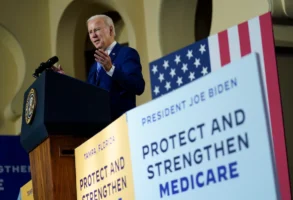
Published April 27, 2017
For nearly a century, American presidents have played an important, if informal, role in our politics as the leader of their parties. But nearly 100 days into his term, President Trump not only has failed to provide Republicans with skilled leadership, but also seems unaware that he’s even supposed to do so. This failure could doom his presidency before it even really begins.
Franklin D. Roosevelt led the way in defining this role. By setting forth a clear thematic and legislative agenda, Roosevelt gave congressional Democrats direction as they set forth to combat the Great Depression. Their successes established the “100 days” benchmark that has now become the standard by which new presidents are judged.
By contrast, Trump has provided neither clear direction nor a firm legislative agenda for his party. Congressional Republicans and neutral observers alike ask: “What does the president really want?” No one should expect modern presidents to meet Roosevelt’s level of achievement, but Trump isn’t even close. We don’t know what form health-care reform will take; we have only a hastily prepared outline of tax reform; and his pronouncements on other policy issues seem to change as often as the Washington weather.
This lack of leadership was on full display as the Obamacare-repeal debacle played out in March. The president allowed House Speaker Paul D. Ryan (R-Wis.) to offer up a bill without his apparent direct involvement. Trump provided no clear direction as to which provisions of the bill he was committed to and which he was willing to discard or amend. This, predictably, meant that every faction of Republicans was encouraged to ask for more, which predictably led to different factions asking for incompatible things. Moderates in swing states and Freedom Caucus members in tea party strongholds inevitably have different no-fly zones. Only clear, principled leadership from the Oval Office could have brought these odd bedfellows into accord. A week or two of lobbying was not enough to accomplish this, and even the White House’s current efforts seem to focus only on the House Freedom Caucus to the exclusion of House moderates or senators.
Absence of political leadership is particularly damaging to the modern Republican Party because of the intense and deep fissures running through it. The GOP was bitterly divided into at least four factions prior to Trump’s emergence, and their civil war had waged since at least the 2010 primaries. None of the existing party leaders has the stature, power or credibility to unite this group into a cohesive majority. The president’s failure to step into this fray simply makes the divisions harder to heal.
This state of affairs is compounded by the way Trump won the White House. He mobilized millions of non-Republicans, mainly whites without college degrees, and brought them behind him in historically high numbers. These voters tend to be more economically liberal than any faction of GOP conservatives and less interested in historic Republican unifying themes such as traditional morality or activism overseas. Their priorities — jobs and rising wages, immigration restriction and focusing our military on fighting terrorism — are all out of step with at least one powerful GOP faction. Unless they are integrated into a new Republican majority, the votes that elected Trump and gave the GOP control of the Senate, House and many big state governorships will vanish as quickly as they arrived.
Fortunately for the administration, the 100-day mark is wholly artificial, so Trump has time to step up. In doing so, he need look no farther than the example of President Ronald Reagan. Reagan also led a party wracked by years of infighting, in his case between moderates, business conservatives and movement conservatives. He also saw many traditional Republicans desert him for a third-party candidate, Rep. John Anderson, in his general election campaign. And like Trump, he prevailed because he attracted millions of traditional Democrats and independents who thought the former movie actor cared more about them than traditional Republicans or Democratic leaders did.
Reagan started his presidency by establishing clear priorities in his opening speeches and followed those pronouncements up with specific legislative proposals. Despite holding only a narrow majority in the Senate and having to lure at least 26 Democratic votes in the House, and despite a brush with death on March 30 after John Hinckley Jr.’s failed assassination attempt, Reagan’s priorities moved quickly through Congress. By May 7 his budget cuts passed the House, and by August his tax cuts were signed into law, both with nearly unanimous Republican backing and significant Democratic support. There is no reason why a determined and dedicated Trump can’t get similar results.
Trump was elected to change Washington and “drain the swamp.” Our modern system won’t allow him to do that without first wading deep into the murky waters himself to corral the alligators. If the president does that by the summer months, he might yet begin to fulfill his promises and move the nation in a new direction. But if he doesn’t, he may find the swamp will have drained his power and authority by the time Congress reconvenes in the fall.
Henry Olsen is a senior fellow at the Ethics and Public Policy Center and author of the forthcoming book “The Working Class Republican: Ronald Reagan and the Return of Blue-Collar Conservatism.”




